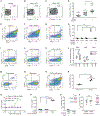A tumor-specific mechanism of Treg enrichment mediated by the integrin αvβ8
- PMID: 33771888
- PMCID: PMC8425767
- DOI: 10.1126/sciimmunol.abf0558
A tumor-specific mechanism of Treg enrichment mediated by the integrin αvβ8
Abstract
Regulatory T cells (Tregs) that promote tumor immune evasion are enriched in certain tumors and correlate with poor prognosis. However, mechanisms for Treg enrichment remain incompletely understood. We described a mechanism for Treg enrichment in mouse and human tumors mediated by the αvβ8 integrin. Tumor cell αvβ8 bound to latent transforming growth factor-β (L-TGF-β) presented on the surface of T cells, resulting in TGF-β activation and immunosuppressive Treg differentiation in vitro. In vivo, tumor cell αvβ8 expression correlated with Treg enrichment, immunosuppressive Treg gene expression, and increased tumor growth, which was reduced in mice by αvβ8 inhibition or Treg depletion. Structural modeling and cell-based studies suggested a highly geometrically constrained complex forming between αvβ8-expressing tumor cells and L-TGF-β-expressing T cells, facilitating TGF-β activation, independent of release and diffusion, and providing limited access to TGF-β inhibitors. These findings suggest a highly localized tumor-specific mechanism for Treg enrichment.
Copyright © 2021 The Authors, some rights reserved; exclusive licensee American Association for the Advancement of Science. No claim to original U.S. Government Works.
Figures







Similar articles
-
Asthma Alleviation by Ginsenoside Rb1 via Promotion of Treg Proliferation and Inflammatory T Cell Inhibition.Allergy. 2025 Jun;80(6):1647-1668. doi: 10.1111/all.16551. Epub 2025 Apr 19. Allergy. 2025. PMID: 40251907 Free PMC article.
-
β8 Integrin Expression and Activation of TGF-β by Intestinal Dendritic Cells Are Determined by Both Tissue Microenvironment and Cell Lineage.J Immunol. 2016 Sep 1;197(5):1968-78. doi: 10.4049/jimmunol.1600244. Epub 2016 Aug 1. J Immunol. 2016. PMID: 27481847 Free PMC article.
-
Mesenteric lymph nodes: a critical site for the up-regulatory effect of hUC-MSCs on Treg cells by producing TGF-β1 in colitis treatment.Stem Cell Res Ther. 2024 Jul 2;15(1):190. doi: 10.1186/s13287-024-03809-x. Stem Cell Res Ther. 2024. PMID: 38956621 Free PMC article.
-
Role of the intestinal flora-immunity axis in the pathogenesis of rheumatoid arthritis-mechanisms regulating short-chain fatty acids and Th17/Treg homeostasis.Mol Biol Rep. 2025 Jun 21;52(1):617. doi: 10.1007/s11033-025-10714-w. Mol Biol Rep. 2025. PMID: 40544212 Review.
-
"What do we know about regulatory T cells and endometriosis? A systematic review".J Reprod Immunol. 2017 Apr;120:48-55. doi: 10.1016/j.jri.2017.04.003. Epub 2017 Apr 10. J Reprod Immunol. 2017. PMID: 28463710
Cited by
-
Regulatory T cell-mediated immunosuppression orchestrated by cancer: towards an immuno-genomic paradigm for precision medicine.Nat Rev Clin Oncol. 2024 May;21(5):337-353. doi: 10.1038/s41571-024-00870-6. Epub 2024 Feb 29. Nat Rev Clin Oncol. 2024. PMID: 38424196 Review.
-
Biomechanics of the tumor extracellular matrix and regulatory T cells: regulatory mechanisms and potential therapeutic targets.Cell Commun Signal. 2025 Aug 21;23(1):375. doi: 10.1186/s12964-025-02380-z. Cell Commun Signal. 2025. PMID: 40842015 Free PMC article. Review.
-
Clinical adoptive regulatory T Cell therapy: State of the art, challenges, and prospective.Front Cell Dev Biol. 2023 Jan 30;10:1081644. doi: 10.3389/fcell.2022.1081644. eCollection 2022. Front Cell Dev Biol. 2023. PMID: 36794233 Free PMC article. Review.
-
Anti-GARP Antibodies Inhibit Release of TGF-β by Regulatory T Cells via Different Modes of Action, but Do Not Influence Their Function In Vitro.Immunohorizons. 2023 Mar 1;7(3):200-212. doi: 10.4049/immunohorizons.2200072. Immunohorizons. 2023. PMID: 36928178 Free PMC article.
-
Blockade of αvβ6 and αvβ8 integrins with a chromogranin A-derived peptide inhibits TGFβ activation in tumors and suppresses tumor growth.J Exp Clin Cancer Res. 2025 Mar 8;44(1):88. doi: 10.1186/s13046-025-03352-4. J Exp Clin Cancer Res. 2025. PMID: 40055773 Free PMC article.
References
-
- Fridman WH, Pagès F, Sautès-Fridman C, Galon J, The immune contexture in human tumours: Impact on clinical outcome. Nat. Rev. Cancer 12, 298–306 (2012). - PubMed
-
- Curiel TJ, Coukos G, Zou L, Alvarez X, Cheng P, Mottram P, Evdemon-Hogan M, Conejo-Garcia JR, Zhang L, Burow M, Zhu Y, Wei S, Kryczek I, Daniel B, Gordon A, Myers L, Lackner A, Disis ML, Knutson KL, Chen L, Zou W, Specific recruitment of regulatory T cells in ovarian carcinoma fosters immune privilege and predicts reduced survival. Nat. Med 10, 942–949 (2004). - PubMed
-
- Shimizu J, Yamazaki S, Sakaguchi S, Induction of tumor immunity by removing CD25+CD4+ T cells: A common basis between tumor immunity and autoimmunity. J. Immunol 163, 5211–5218 (1999). - PubMed
-
- Onizuka S, Tawara I, Shimizu J, Sakaguchi S, Fujita T, Nakayama E, Tumor rejection by in vivo administration of anti-CD25 (interleukin-2 receptor α) monoclonal antibody. Cancer Res. 59, 3128–3133 (1999). - PubMed
Publication types
MeSH terms
Substances
Grants and funding
- U54 HL119893/HL/NHLBI NIH HHS/United States
- K01 DK099405/DK/NIDDK NIH HHS/United States
- T32 AI007334/AI/NIAID NIH HHS/United States
- P30 DK026743/DK/NIDDK NIH HHS/United States
- R01 HL113032/HL/NHLBI NIH HHS/United States
- F31 DK112607/DK/NIDDK NIH HHS/United States
- HHMI/Howard Hughes Medical Institute/United States
- S10 OD020054/OD/NIH HHS/United States
- U01 CA217864/CA/NCI NIH HHS/United States
- P41 CA196276/CA/NCI NIH HHS/United States
- R01 HL165175/HL/NHLBI NIH HHS/United States
- R01 CA197363/CA/NCI NIH HHS/United States
- R01 DK093646/DK/NIDDK NIH HHS/United States
- R01 HL134183/HL/NHLBI NIH HHS/United States
LinkOut - more resources
Full Text Sources
Other Literature Sources
Medical
Molecular Biology Databases
Research Materials

